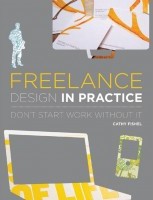
When I first starting moonlighting as a ghostwriter, I felt like I was cheating on my full-time role. Even though I was still putting my all into my 9-to-5 job when I was there, I was continually finding my side gigs far more rewarding than what I was accomplishing at the office. It took me nearly a year to get to a solid place of excitement and confidence, but when the day came to put in my notice, the timing felt right. I would have killed for a laundry list of signs indicating that I was truly ready to make the leap, though.

That said, and with the help of several full-timers turned creative entrepreneurs, I’ve compiled six signs that you’re ready to make the leap from employed to self-employer. If you’re contemplating going out on your own, take a look and don’t jump ship until you’re 100% confident you’ll float.
1. It feels like your full-time job is “getting in the way” of your side work.
Jonnie Hallman, Brooklyn-based designer and founder of Cushion, a forecasting app for freelancers, couldn’t shake his passion for independent work even if he tried. He’d race home after his day job so he could maximize time spent on side projects until it became clear that change was in order.
“I’d catch myself daydreaming about side projects constantly. All of a sudden, 5 p.m. - 2 a.m. became ‘my’ time. I’d try to accomplish as much as I could before returning to my real job the next day,” says Hallman. “When the side projects started taking off, I found myself being recognized far more for that work than anything I did at my full-time job.”
2. You’ve learned everything you can in your current role.
There’s a reason why it’s rare for recent graduates to start out as freelancers. Sure, it’s doable, but the experience and professional skills you gain when working in a creative role for a company or agency are irreplaceable.
Becky Simpson, illustrator and founder of paper-products store Chipper Things, comments, “I think working for a company you believe in, whether it’s a few years or a lifetime, is a great thing and shouldn’t be seen as ‘lesser than’ working on your own.” Back when she was in college, Simpson knew she wanted to work for herself eventually. She adds, “That’s part of why I studied graphic design—I figured it would be a flexible career. I really loved my design job, but started to feel disconnected from my work. I felt like I was bursting at the seams with ideas and I wanted unlimited time to pursue them.”
3. You’re okay with living frugally.
I have a frivolous success metric for my first year of being on my own. It’s whether or not I can continue to buy makeup from Sephora, versus switching to less-expensive Ulta. (Yes, this is ridiculous but it’s measureable.)
Visual artist Hannah Rothstein left a communications role to focus on her own projects, including the humorous book Yoga for Bros, full-time. She shares, “If you’re thinking of quitting, make sure you’ve saved up several months of living expenses and are comfortable living frugally. If you like to make it rain, quitting a steady job might not be the best idea for you.” She adds, “Before quitting, it’s also a good idea to decide what your ‘oh-shit point’ is. This is the financial threshold that, once you dip below it, signifies it’s time to start looking into your Plan Bs.”
4. You’ve started to feel more excited by risk than you are fearful of it.
Leaving a full-time job to start your own venture is a form of entrepreneurship, and entrepreneurship is just-plain scary. You’re putting what you have on the line and a wide range of skills, from branding to sales, are required to make it all work. Taking on such an endeavor is indeed a risk, but if you’ve planned well, it’s an intelligent risk to take and it can be extremely exciting.
Simpson shares, “I kept thinking ‘if not now, when?’ When you’re holding back for no reason other than just being scared, it’s worth taking the risk.”
5. You’ve planned accordingly (task-wise and money-wise).
From building up clientele in advance of your last day at the full-time gig to fleshing out contingency plans in case freelancing doesn’t work out, your business plan is comprehensive and answers all of your “what ifs”. Even more importantly, you’ve saved a few months’ worth of cash to help cover unplanned costs during your first few months in business.
Hallman shares, “I’ve had countless surprise expenses that I didn’t plan for, so I found myself scrambling when I thought I’d be coasting. Even though I’ve been solo for a while now, I still have those ups and downs, but I’ve learned to deal with them.” (Quarterly tax filing is a whole different ball game so be prepared for that too.)
6. You’ve been planning this switch for three months or longer.
We all get frustrated with work from time to time, but just because you’re over your current role or company isn’t a reason to go out on your own. Wanting to pursue projects that you’re passionate about should be what’s driving you (not hasty decisions).
Rothstein says, “Quitting spontaneously is seldom a good call. However, if you’ve been feeling the slow burn of discontent for months, sense a deep-seated desire in your core to do your own thing, and have thought about what you’d do if things don’t work out as planned, it’s time to go for it.” She adds, “I knew it was the right decision.”
Even though the idea of leaving the security of a full-time role can be scary, remember that you’re not the only one trying it out! According to an independent study commissioned by Freelancers Union and Elance-oDesk, 53 million Americans are working as freelancers (a number that’s said to rise in coming years). That means there’s a huge network of freelancers and resources out there to help lead the way.
Hallman adds, “Surround yourself with a good support group of people in the same position, help each other out, and learn from each other. You’ll find that the freelance community is strong and full of people willing to lend a hand.”

Related Resources:
- Online Workshop – Getting Down to Business: 8 Action Planning Steps for Creative Freelancers
- Freelance Design in Practice
- Starting Your Career as a Freelance Illustrator or Graphic Designer







Laura, Nice article!!! Making the decision to become a freelancer can be a life-changing one, You just have to decide if you’re willing to take the risk or not. Depending on your individual skills opportunity to build your own reputation.
You’re right. It’s all about being comfortable with risk.
This is a great article, Laura! I couldn’t have said it better myself. I especially loved what you wrote about learning all you can in your current role. You really hit the nail on the head. All the information you learn at a 9-5 is so vital to your career as a freelancer. Not to mention, it’s great to tell clients you have experience doing something at a large company. No need to rush out of your current role. Soak it all up while you can!
-Nicole
freelancebydesign.com
Great article! Starting your own gig is challenging, keeping it going is even hard, and then growing it is even harder. What’s worse is unlike a 9-5 with a boss, you have to figure it out all on your own. Adding another layer of complexity to the everyday life of owning your own creative business. BUT…. that’s why we have the Designers Roundtable - a community where solo creative business owners can come together and share resources, brainstorm business development, and grow together - breaking the overwhelming isolation that comes from a solo gig.